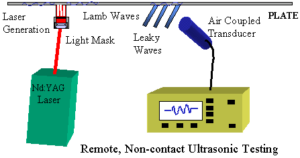Air Coupled Inspection
Acoustic emission (UT) Air-coupled ultrasound is a non-destructive testing method.
An ultrasound system generally consists of a receiver and a transmitter. A special quality of “air-coupled ultrasound” is the use of the surrounding air as a couplant between the specimen and transmitter or between specimen and receiver and not the typical ultrasound gel or water.
The main difference between these both approaches lies in the coupling of a test specimen to the associated testing system. An inspection method without any need of physical coupling to the tested material.
Air-coupled ultrasonic testing requires separate transducers as a sender and receiver on opposite sides of the component. Pitch and catch techniques require only a single-sided access. Because of critical adjustments, this method is only preferable for laboratory applications.
When sound passes across an interface between two materials only a proportion of the sound is transmitted, the rest of the sound is reflected. The proportion of the sound that is transmitted depends on how close the acoustic impedance of the two materials matches
There are three kinds of measurement based on transducer arrangement
- Normal through-transmission
- Shear transmission
- One-sided measurement



